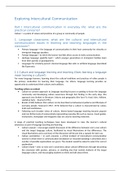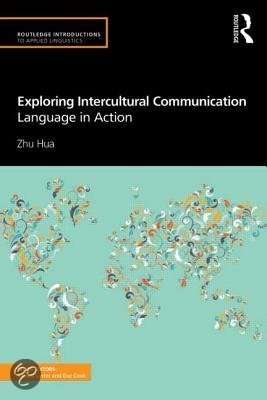Exploring Intercultural Communication
Part I Intercultural communication in everyday life: what are the
practical concerns?
Culture = a system of values and practces of a group or community of people.
1. Language classrooms: what are the cultural and intercultural
communication issues in learning and teaching languages in the
classroom?
Primary language = the language of communicaton in their host community for minority or
immigrant language speakers.
Foreign language = to which the learner has litle direct access in daily communicaton.
Heritage language (geërfde taal) = which younger generatons in immigrant families learn
from their parents or grandparents.
Languages for scholarly pursuit: classical language like Latn or artificial language (kunsttaal)
like Esperanto.
1.1 Culture and language learning and teaching (Does learning a language
mean learning a culture?)
For many language learners, learning about the cultural traditons and practces of other people is
the primary motvaton for learning their language. For others, language learning provides an
opportunity to understand their culture and traditons.
Teaching culture as content
Culture-as-content approach to language teaching focuses on getng to know the language
community and developing culture awareness through fact fnding. In the early days, this
approach was limited to literature, history and geography (the four Fs: food, fairs, folklore,
statstcal facts – raramsch 1 991 )..
Brooks (1 960). believes that culture can be described as behavioural paterns and lifestyles of
everyday people. Nostrand (1 967, 1 974). believed that a culture is characterised by values,
traits and worldviews.
Following such broader views of culture, theme-based language teaching became popular
and non-fcton texts of various kinds representng everyday life such as menus, travel guides,
instructons, newspaper and magazine clips are used as teaching materials.
A range of practcal teaching techniques have been developed to raise the learner’s cultural
awareness as part of language teaching and learning:
Culture capsule = encourages explicit discussion of the diference between one’s own culture
and the target language culture, facilitated by visual illustratons of the diferences. The
visual illustratons and a summary of the discussion will be put into a capsule for later use.
Culture assimilators = in each scenario, a critcal incident of intercultural communicaton
(events in which there is communicaton breakdown or misunderstanding). is described and a
number of possible explanatons are given. The student would be asked to select the correct
explanaton.
Culture island = aims to raise one’s awareness about cultural diferences through decoratng
the classroom with posters, pictures, or anything else that remind students of the target
language culture, and encouraging students to think and talk about them.
, Drama = provides an opportunity for students to act out intercultural interactons in which
misunderstandings take place, and then to explore possible explanatons and solutons in the
classroom.
Teaching language-and-culture: an integrated approach
There is a range of perspectves on what is to be integrated and how to integrate it:
The need to integrate the learner’s natve culture and language into language and culture
learning (Crawford-Lange and Lange 1 984).. This perspectve gives more atenton to the
learner’s background.
The need to integrate culture at all levels of language teaching (Hymes 1 972).. The idea that
the knowledge of how to use and interpret a language in an context-sensitve and culturally
appropriate way is essental to successful communicaton. Crozet and Liddicoat (1 977).
analysed the way culture infuences the spoken and the writen language and demonstrated
how culture is embedded in all aspects of language use.
The need to make cultural awareness an essental and integrated component of
communicatve competence. Byram (1 989). played a role in the cultural turn in language
teaching placing culture at centre stage in language and culture pedagogy. In his early model
for foreign language teaching he included cultural awareness, cultural experience and
language awareness in additon to language learning.
Teaching culture through language: an intercultural approach
Intercultural language and culture pedagogy (Corbet 2003). believes that the goal of language
learning is not to develop perfect linguistc skills, but to become an intercultural speaker who can
mediate between diferent cultures and diferent viewpoints.
Symbolic competence = the objectve of language and cultural learning is not to replace one’s natve
language and culture with a diferent one, but to defne for learners themselves a third culture or
third place to refer to a symbolic space where one’s own and the target culture interact with each
other (raramsch 2009)..
Moving towards a critcal understanding of the noton of culture in global cultural fows
Atkinson (1 999). reviewed diferent practces regarding the noton of culture:
A received view = this view ofen surfaces through an uncritcal use of terms such as Japanese
culture, Hispanic culture, American culture etc.
A received-but-critical view = sees cultures as a collecton of shared values.
The third view = recognises culture as a problematc concept and turns to terms such as
identty and a postmodernist alternatve to traditonal approaches to culture.
Some recent studies take account of the impact of globalisaton on the relatonship between
language and culture:
Risager (2006, 2007).: learning a language is no longer just getng to know the language area
in a geographical sense but the worldwide network of the target language; the target
language exists not only as frst language, but also second and foreign language.
Pennycook (2007).: the ways in which cultural forms move, change and are reused to fashion
new identtes in diverse contexts (= transcultural fows)) He examined how global Englishes
and transcultural fows form a circular process of local adaptaton, transcending local
boundaries and infuencing other linguistc varietes, and then returning with new forms and
meanings.
Baker (2009).: challenges the conventonal way of linking one language with one culture and
revealed that cultural forms, practces and frames of reference should not be viewed as
predefned categories.
,
, Conclusion
Does learning a language mean learning a culture? It is clear that culture has an important role in
language learning, and learning a language inevitably involves learning a culture. However, the
approaches difer in the degree of importance atached to culture, the ultmate goal of language
learning and how language and culture relate to each other in language teaching and learning.
1.2 Culture of learning (How many times do I need to practice?)
How people learn may depend on how members of their cultural group view learning as a social
actvity. Studies of learning styles and learning strategies have identfed a number of contributng
variables: culture and language background, language profciency, motvaton, age, gender, length of
tme living in the target culture and studying in the target culture.
Learning styles = general approaches that students use in learning a new language or any other
subject.
Learning strategies = specifc behaviours or techniques learners use to enhance (uitbreiden). their
learning.
Culture of learning
Jin and Cortazzi (1 998). propose the noton of culture of learning: culturally based ideas about
teaching and learning, including appropriate ways of learning and partcipatng in class,
relatonship and communicaton between teachers and students etc.
A learner-centred pedagogy is preferred to a teacher-centred one: learner autonomy
(onafhankelijkheid). and the role of the teacher as facilitator (bemiddelaar).. The diferences
between these two cultural models are due to diferent cultural values and beliefs that are
dominant in the respectve societes.
Challenges with language learning
Socio-economic and geopolitcal factors and natonal and regional policies on foreign
language educaton also impact on the learner’s motvaton and goals in language learning,
learning styles and strategies.
The risk of imposing (opleggen). values and educatonal practces of Western societes or
dominant cultural groups and the related ‘deficitt (verlies) model: treatng anything that
difers from dominant practces as less adequate and in need of improvement. Some myths
or common misperceptons associated with a partcular group of students may be due to a
lack of understanding of the nature of learning and teaching practces concerned. The
challenge for practtoners is to recognise and encourage autonomous behaviours which
ofen disappear or remain undetected beneath the radar of Western educatonal pedagogy.
Conclusion
It is important to recognise that diferent cultural, ethnic and natonal groups may have diferent
preferences towards learning and teaching practces as the result of diferent cultural values and
beliefs, socio-economic and geopolitcal factors, and related natonal and regional policies, among
other things. It is also important to avoid any imposed (opdringen). interpretaton and to recognise
that these cross-cultural diferences in teaching and learning styles need to be critcally examined in
their cultural and historical contexts.
1.3 Multicultural classrooms (Why is she so quiet in the classroom?)
Multicultural classrooms = where students from diverse linguistc, ethnic and cultural backgrounds
are taught and work together.





